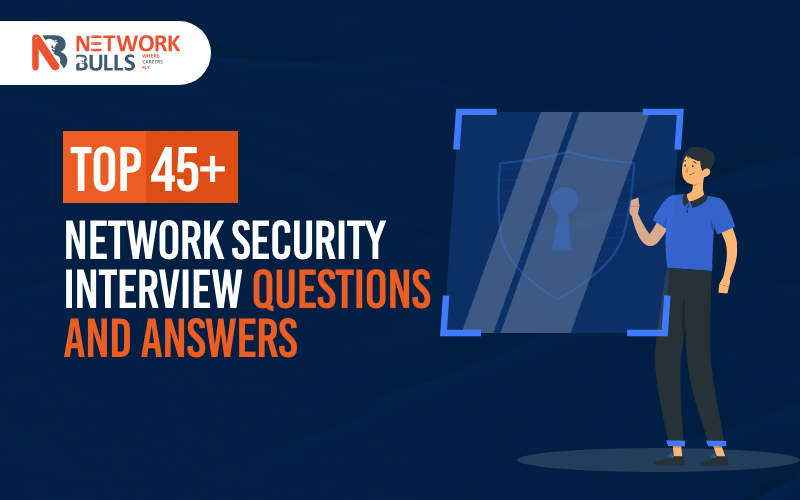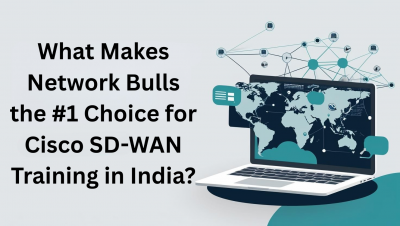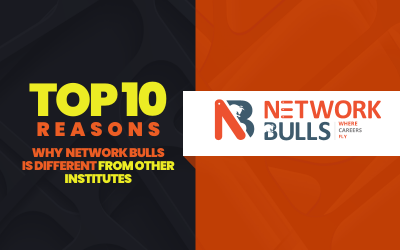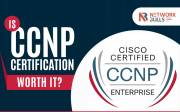Top 45+ Network Security Interview Questions and Answers

If you are aspiring to become a network security specialist, you must prepare yourself for the tough exam which you must pass to obtain the Cisco security certification. Much of your success in the exam depends on your academic exposure to network security Q&A.
This mandates that you know the network security questions and answers. The questions are not easy. You have to demonstrate your thorough understanding of security issues during the written test and also demonstrate your practical knowledge in handling the Cisco products at the lab test.
As the network security course is vast, you must devote sufficient time to complete it. You will be asked quite a large number of questions. All your answers must be correct. Due to this reason, you must be familiar with the nature of questions and their answers.
Top 45+ Network Security Interview Questions and Answers
We are listing below 45+ such interview questions and their answers:
Network Security Q1. What do you understand by Protocol?
Answer: Protocol is meant by the various rules or technical systems that govern all functional or operational aspects of data communication from one end to another.
Network Security Q2. Can you explain different layers of the OSI?
Answer: The OSI has different layers. They are:
-
Data Link layer
-
Transport layer
-
Application layer
-
Session layer and
-
Presentation layer
Network Security Q3. How can you explain Pipelining?
Answer: If a given task begins before the completion of the previous one, it can be termed as Pipelining.
Network Security Q4. How can you differentiate a Hub from a Switch?
Answer: There are differences between the two. While hub is a networking device used to connect different or many computers together, switch basically is a control unit that turns the flow of electricity in a circuit.
Network Security Q5. Can you explain which layers are termed as network support layers?
Answer: The network support layers comprise the following:
-
Data Link layer
-
Physical layer
-
Network layer
Network Security Q6. Can you define simplex with an example?
Answer: A type of communication in which data is transmitted in one direction is known as simplex. Example: Monitor
Network Security Q7. What do you understand by RIP?
Answer: Routing Information Protocol is known as RIP in the networking domain. It is a simple protocol used for data exchange between routers.
Network Security Q8. Can you list out the factors that affect the performance of the network?
Answer: Following factors affect a network’s overall performance.
-
Type of transmission media
-
Software or type of software used
-
Total number of users of a particular network
-
Hardware used in networking
Network Security Q9. How can you differentiate between a wired LAN and a wireless LAN?
Answer: Main differences are:
-
Wired LAN uses Ethernet devices like router, hub, and switch
-
Wireless LAN uses MiFi router and WLAN router.
Network Security Q10. Can you identify or name some user support layers?
Answer: Some of the user support layers are:
-
Application layer
-
Presentation layer
-
Session layer
Network Security Q11. What is the main purpose of TCP in IP packets?
Answer: The acronym or initials TCP stands for the Transmission Control Protocol. TCP is a communications protocol in a private network.
Network Security Q12. What are the types of errors that usually occur in data communication over a network?
Answer: There are two types of errors that occur in data communication over a network. These two types are:
-
Single bit error
-
Burst error
Network Security Q13. What is ALOHA?
Answer: This particular networking term refers to a technical system for coordinating and arbitrating access to a shared communication network channel. ALOHA is often applied to solve the channel allocation issue. There are two types of ALOHA: Pure Aloha & Slotted Aloha.
Network Security Q14. What are the protocols that are used in the application layer?
Answer: There are mainly four protocols that are used in the application layer. they are: SMTP, DNS, TELNET, & FTP.
Network Security Q15. What do you mean by an intranet?
Answer: Intranet is a private network based on TCP/IP protocols. Intranet can be accessible only by the members or someone authorized by a corporate company or organization.
Q16. If you are creating the Checksum, what steps would you take for that purpose?
Answer: If you are creating a checksum, you have to take a few steps. The steps required for the creation of checksum are:
-
Divide the data into sections
-
Add the sections together using 1’s complement arithmetic
-
Take the complement of the final sum
Q17. We use various network security tools. Can you list them out?
Answer: There are a large number of tools that are used to ensure network security. They can be listed in the following manner:
-
Access control
-
Antivirus and antimalware software
-
Application security
-
Data Loss Prevention (DLP)
-
Email security
-
Firewalls
-
Intrusion prevention systems
-
Mobile device security
-
Host-based Intrusion Detection System (HIDS)
-
Network Intrusion Detection System (NIDS)
-
Behavioral analytics
-
Network segmentation
-
Virtual Private Network (VPN)
-
Web security
-
Wireless security
Q18. Can you explain how network security works?
Answer: Network security is designed in such a way that no unauthorized third party entity can breach it. To protect the network integrity, both hardware and software technologies are applied. Different threats are regularly analyzed and different protective layers are created at the edge and in the network to thwart intrusions or attempts to hack the network.
Q19. Can you explain AAA in network security?
Answer: Authentication, Authorization, and Accounting, commonly known as AAA, relates to the protocols that acts as intermediary to access the network. This means AAA is a framework to track all network activities including control of user access and implement policies.
Q20. What are the different methods of user authentication in a network?
Answer: The most used and common user authentication methods are:
-
Biometric Authentication
-
Password Authentication Protocol (PAP)
-
Authentication Token
Q21. How can you explain IPS in network security?
Answer: Intrusion Prevention System or IPS which is also termed as Intrusion Detection Prevention System or IDPS, tracks the network for any suspicious aimed at using a known vulnerability. After zeroing on in such a doubtful activity, it either allows or prevents the threat (after scrutinizing its genuineness or fakeness.
Q22. What can happen after a network security is attached to breach it?
Answer: A network is always at risk of being breached. If it is hacked, intruded by third party or compromised, the following things may happen to it:
-
Data Loss
-
All secret, confidential and sensitive enterprise information may fall in the hands of an intruder who can be your business rival.
-
Loss of reputation
-
Losing confidence of investors, partners, and shareholders over the management of the company.
Q23. How can you explain the Administrator Privileges? Why you require such privileges while trying to install a download?
Answer: These are some specific permissions given to users by the administrators to create, delete, and modify items and settings. You cannot do any modifications in the system without the privileges given to you by the administrator.
Q24. How can you define network encryption?
Answer: Network encryption includes different tools, techniques, and standards to encrypt a message to maintain its secrecy. The encrypted message is unreadable and transmitted between two or more network nodes. As a result, any third party unauthorized entity cannot read it even if it is downloaded or copied. The encrypted message can be decrypted and converted back into its original form only by using encryption/decryption keys.
Q25. What is the CIA Triad?
Answer: Confidentiality, Integrity, and Availability (CIA) or CIA Triad is a model designed to maintain privacy policies for information security. Application of CIA Triad is necessary to fully secure a network.
Q26. Can you list out the benefits of a firewall?
Answer: The Firewall can give you the following benefits:
-
Monitors network traffic
-
Enhances Privacy
-
Stops Spyware and all other viruses
-
Prevents intrusions, breaching attempts and hacking
Q27. What is a Proxy firewall?
Answer: This is an early type of firewall device acting as the gateway from one network to another for a specific application. Besides protecting network resources by filtering messages at the application layer, it also operates at the application layer through the proxy. It does so by creating and running a process on the firewall that mirrors a service. This process makes it appear as if it is running on the end host.
Q28. What do you understand by a UTM firewall?
Answer: A UTM (Unified Threat Management) firewall can be either hardware or a software device. Such a device assembles different security functions, like a proxy, packet filtering, intrusion detection and prevention systems, protection against malware and application control.
Q29. What is Stateful Inspection?
Answer: Stateful Inspection is also known as dynamic packet filtering. It is a specific firewall technology meant to inspect and monitor the state of active network connections by keeping track of all activities right from the opening of a connection until it is closed.
Q30. What is a DDoS attack?
Answer: If a Distributed-Denial-of-Service (DDoS) attack takes place, it can continuously flood the system with frequent data requests. DDoS attacks aim to disable and disrupt the target network to harm the enterprise business operations.
Q31. DDoS attacks have certain types? Can you narrate them?
Answer: DDoS attacks can be categorized in the following ways:
-
Volume-based attacks: massive traffic rush to flood and overload the network bandwidth
-
Protocol attacks: meant to or attempted to exploit server resources
-
Application attacks: targeting the web applications.
Q32. What is Ransomware?
Answer: It is malicious software that allows hackers to block you from accessing your data by encrypting. Decryption is possible only when the hacker is paid a ransom. The form of ransom payment is usually through cryptocurrency.
Q33. What is the modus operandi of Ransomware?
Answer: Ransomware’s entry into your network can be caused by several ways with downloading a spam email attachment being the most common one. The other ways of working of Ransomware are: Through social engineering, Downloading malicious software, and Malvertising, which is also called obnoxious advertisements.
Q34. Can you name types of Ransomware.
Answer: They can be named in the following way:
-
CryptoLocker
-
WannaCry
-
Bad Rabbit
-
Cerber
-
Crysis
-
CryptoWall
-
GoldenEye
-
Jigsaw
-
TeslaCrypt
-
TorrentLocker
-
Locky
Q35. What is Malware?
Answer: Malware stands for Malicious Software. It denotes viruses, worms, adware ransomware, and spyware. They aim at destroying your data and disable your network system. Malware is pushed into your network through a link or file over email. Once you click and open the link or file, the Malware will turn active.
Q36. What is Spyware?
Answer: Spyware aims to gains access to your computer and report back to a remote user who is interested in your data assets. Spyware does this without your knowledge. Spyware is used particularly to gain your personal and financial information.
Q37. What is Adware?
Answer: This malicious software aims to steal data of your computer usage and show appropriate advertisements on your screen. Adware can redirect your browser to unsafe sites and even contain Trojan horses and spyware.
Q38. What is Phishing?
Answer: Under Phishing, you are sent fraudulent emails, calls, or text messages from entities that appear very known and reputed ones. They will ask you to share your passwords, credit card numbers, and other sensitive financial information.
Q39. How does phishing work?
Answer: Phishers invents methods to send messages appearing as if they are from genuine and trustworthy entities. Such emails are very convincing leading to the victim to divulge credit or debit card numbers, their PINs, bank account numbers and other data regarding their financial issues. This modus operandi of Phishers may subject a victim to lose money from an account of a bank or their credit or debit cards being used for illegal purchases by a third party unknown entity.
Q40. What are different types of phishing?
Answer: Phishing attacks can be carried out using the following types or methods:
Email Phishing: This type of phishing is carried out by an entity through registration of a fake domain. Such a domain appears very much genuine. The Phisher will ask you of your sensitive information mostly pertaining to financial affairs.
Spear Phishing: It is carried out by the Phisher after searching the person’s information available on social media platforms.
Whaling: This type of attack is carried out against a person working in senior level in a corporate company. The Phisher would steal the person’s confidential data which can be used for unauthorized purposes.
Smishing and Vishing: In the Smishing type of attack, the Phisher contact a person through text messages. Vishing strategy involves a telephonic conversation.
Q41. What is the full form of VPN?
Answer: VPN is the short form of Virtual Private Network which is used to create a secure network connection over a public network like the Internet.
Q42. What is the use of a VPN?
Answer: A VPN, being an encrypted connection over the Internet from a device to a network, is used to ensure online privacy and anonymity. The anonymity is ensured by creating a private network from a public internet connection.
Q43. What are the different types of VPNs?
Answer: The types of VPNs are: Remote access and Site-to-site
Q44. How can you describe Shadow IT?
Answer: This term refers to using IT systems, software, devices and applications without the knowledge of a company’s IT or security group. Under Shadow IT, its illegal operators handles or executes different projects that are managed outside of and without the knowledge of the organization’s IT department.
Q45. Can you exemplify Shadow IT?
Answer: Several examples of Shadow IT can be given. The most common ones are:
-
Different IT-related activities that the company’s IT department is not aware of
-
Different purchases that the IT department is unaware of.
-
Different projects carried out without the permission of IT department of the company.
Q46. Can you explain the terms Risk, Vulnerability and Threat in the context of network security?
Answer: These three terms can be explained in the following manner:
Risk denotes that a network system is secure but sufficiently enough to thwart all third party intrusions. The network may be susceptible to risk.
Vulnerability is a weakness in a network or equipment like modems, routers or access points.
Threat is the real reason for causing an incident like a virus attack is considered a threat.
Conclusion
These are the questions and their answers that you must be thorough with to pass the exam. Want to learn more about Network Security or to get enrolled at Network Bulls’ 100% job oriented programs, call us at 1800-313-2545 now!
- RECOMMENDED POSTS
-
Trending (0)

-
Network Bulls Placements (54)

-
CCIE (101)

-
CCNP (32)

-
CCNA (40)

-
Awards (14)

-
Network Bulls Reviews (53)

-
Informational Articles (74)

-
Technical Articles (26)

-
CCIE Success Stories (40)

-
Summer Training Courses (5)

-
CCIE Security Version 5 (34)

-
CCIE Data Center (19)

-
MCSE (3)

-
Industrial Training (10)

-
Microsoft Certification (3)

-
Ask NB (7)

-
Network Bulls Offers (6)

-
Best Institute for CCIE Training in India (118)

-
CCIE Training Courses (78)

-
DHCP (2)

-
Webinars (6)

-
Training (128)





















